Bird City Brunswick is looking for a signature bird to represent Brunswick. The birds have been narrowed down to the following eleven: Belted Kingfisher; Great Blue Heron; Wood Duck; American Kestrel; Barred Owl; American Crow; Northern Cardinal; Tufted Titmouse; Northern Parula; Cedar Waxwing; Prothonotary Warbler. Below is a short description of each, with a picture from our own local Brunswick photographer, Eric Stuyck.
Brunswick Bird Contestants:
BELTED KINGFISHER
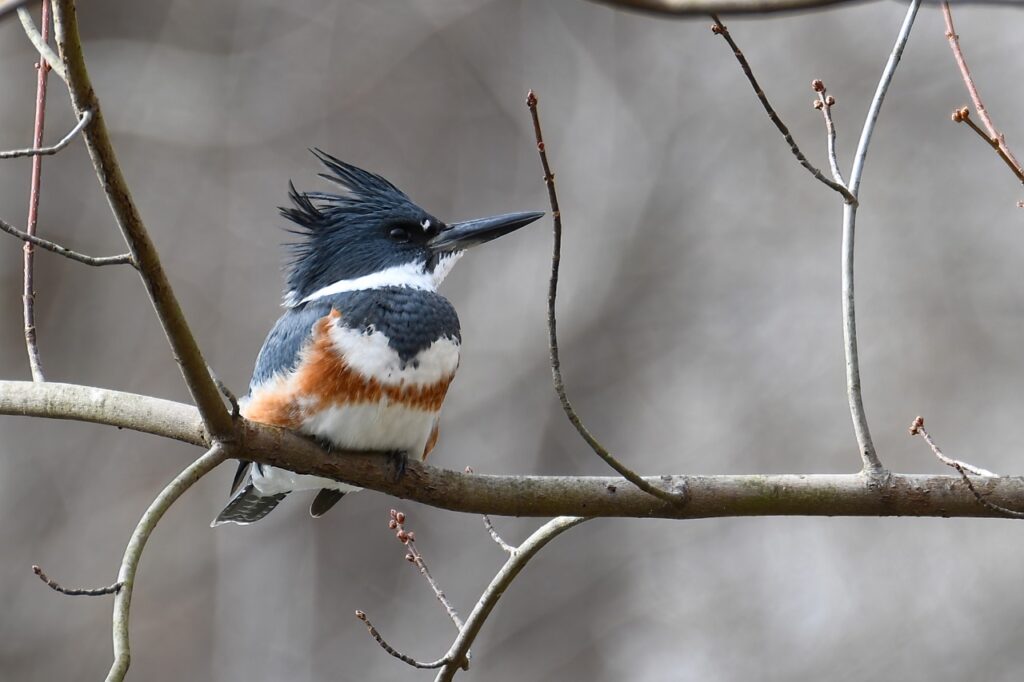
Eric Stuyck
The Belted Kingfisher is a fluffy-headed bird with an oversized spear-like beak that lives near rivers, lakes, estuaries, and pond banks where it can sit on nearby perches and hunt for food. Once they spot their prey, with a flash of their wings, they plunge full speed into the water where they use their beaks like tongs to grab their food. They are also one of the rare large birds, and one of two on our list, that can hover. The American Kestrel is capable of hovering by using the wind to stay in one spot – even if it is slight, but the Belted Kingfisher can hover without wind (true hovering). Unlike hummingbirds, they are only able to get lift on the downstroke and have to adjust their wings, tail, and feathers constantly to achieve hovering. They can be seen flapping furiously to hover above the water and then dive head first after their food. If you see a Belted Kingfisher hovering, rejoice in your amazing luck and try to get some pictures of this incredible achievement. They have a mostly aquatic diet of fish, crustaceans, and amphibians such as crayfish, frogs, and aquatic insects, but may also travel onto land to hunt for rodents and lizards. They are the only bird on the list to nest exclusively on the ground, making their nests in horizontal burrows, usually 1 to 5 feet in length, that both parents help dig. This land-based nesting habit makes them extremely susceptible to wild cat colonies. Because they require an undisturbed berm for digging and constructing their nests, they are easily susceptible to habitat loss caused by development and disturbances from people overusing the river banks. Human activity has created some scenarios that create possible nesting locations for the birds – sand and gravel mine pits and road ditches. So if you see a hole about 8-12 inches in diameter in a bank or berm, don’t disturb it, wait some time, and maybe you will get to see a Belted Kingfisher family arriving home. The Belted Kingfishers live year-round in the Maryland area, but migratory Belted Kingfishers can live as far north as Alaska and as far south as Central America, and have even been seen as far south as the Galapagos. The adorable Belted Kingfishers make a rattling sound as one of their calls, which is why a group of Belted Kingfishers is called a ‘rattle’ or a ‘kerfuffle’.
GREAT BLUE HERON
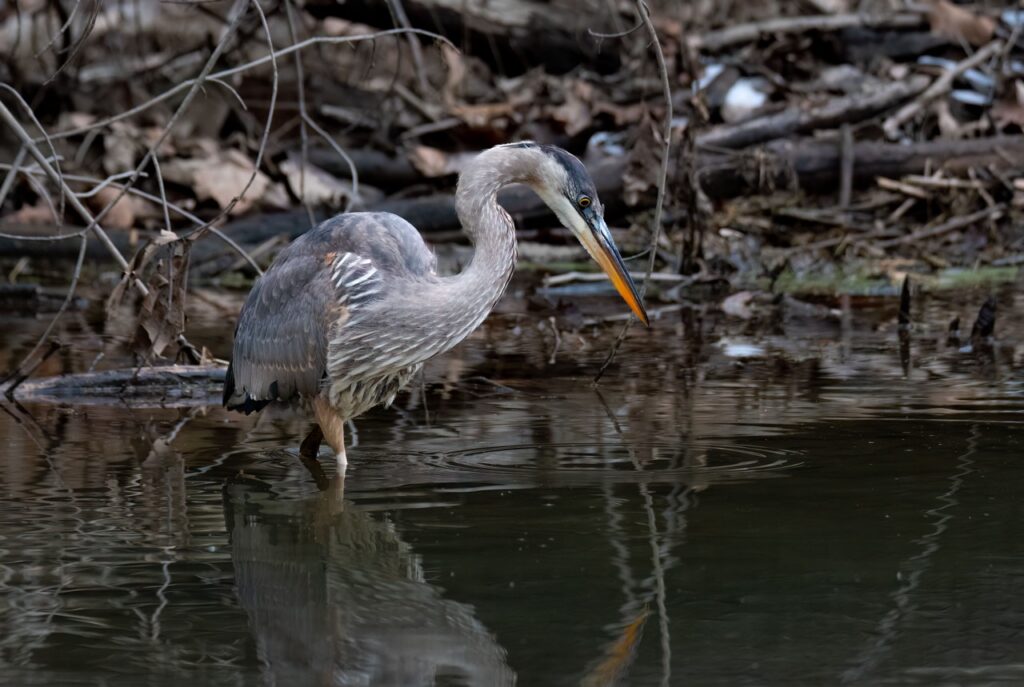
Eric Stuyck
The Great Blue Heron is present across North America all year round, living primarily along rivers and other shorelines ranging from the Gulf of Mexico to the shores of Alaska. They are permanent residents in Maryland, but some of the birds will migrate depending on how far north they breed. They are a large bird reaching up to 4-5 feet in height with an enormous six- foot wide wingspan. They are easily spotted flying overhead because of their giant size and distinct front-heavy flying form, caused by them tucking their necks in an S-shape into their body while in flight and having their long legs outstretched behind them. Once you have seen a Great Blue Heron in flight, you will always be able to identify them. They also have calls that are deep and throaty, and bring up images of prehistoric creatures, something that once you hear it you will never forget. They have a carnivorous diet, eating mostly fish and small creatures such as amphibians, reptiles, and rodents such as voles. They stand dead still, waiting for their prey, and then stab with a lightning quick lunge of their pointy bill. Great Blue Herons spear their food to kill it and then swallow it whole. They are very patient hunters and can often be seen in early morning or early evenings standing still or slowly stalking along the shallows. They have excellent vision, about 3 times better than ours, and can see well in the day or night. They use their stellar eyesight in combination with their long flexible necks to see in any direction and at any angle, making them exceptional hunters. Breeding, in the Maryland area, begins as early as February and continues well into May. Great Blue Herons build their nests in a variety of places; in low shrubs, a few feet off the ground, over a hundred feet up, and—if the area is absent of predators—they will even build on open ground. They nest in colonies, or ‘rookeries’ with a few to several hundred pairs and do best when they are not around human disturbances and have hunting areas nearby. Their nests are made of sticks and are lined with small sticks, bark, and conifer needles and can range in size from 2 to 4 feet across and 3 to 4 feet deep, and mating pairs will often reuse their nests, adding to them each year. Hatchlings can’t fly until they are two months old and then they continue to return to the nest as they learn to hunt. Once the fledglings are capable of surviving on their own, the parents and juveniles return to their solitary lives along the rivers, marshes, lakes, or beaches.
WOOD DUCK
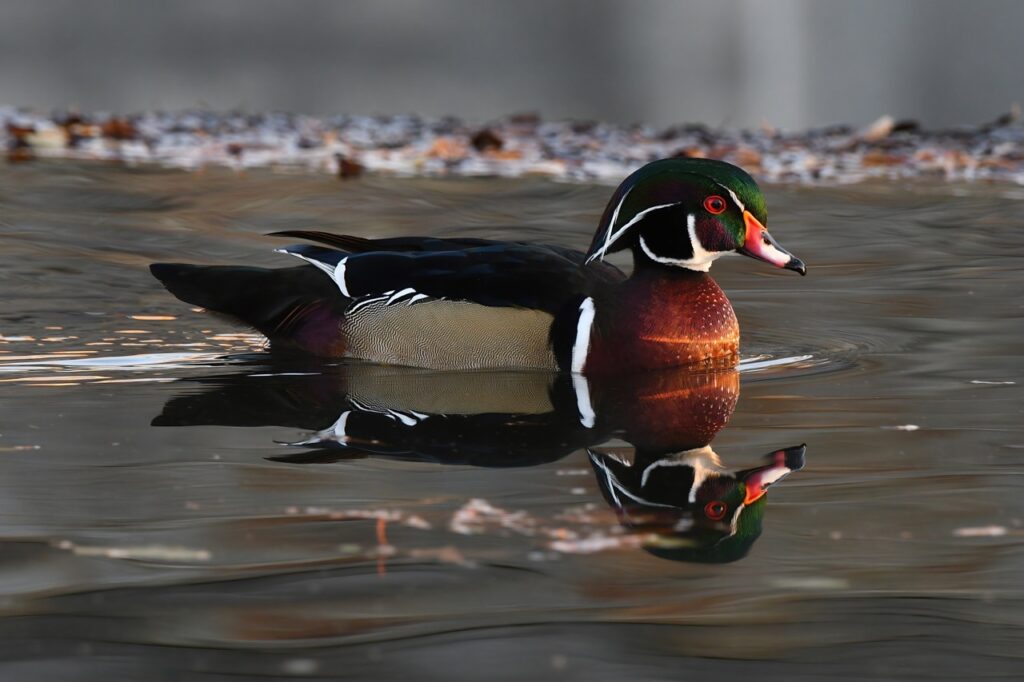
Eric Stuyck
The male Wood Duck, a ‘drake’, is one of the most recognizable and beautiful birds in the United States with its red eyes and bill, metallic green head and crest, and distinctive patterned heads. They are present in the Maryland area through the summer breeding season, until the winter when they fly south, although sometimes a few individuals will stay as year round residents. In the summer, their range extends farther north into the cooler climates. Their habitat is wetlands, ponds, lakes, rivers, and streams, preferably with adjacent forests or marshlands. They are primarily vegetarians, eating mainly aquatic plants, and seeds such as sedge seeds, tubers, wild rice, fruit, and nuts, but as juveniles, they eat invertebrates, insects, crustaceans, and small fish. Wood ducks are a ‘dabbling’ duck. Dabbling is the method by which they eat, paddling across the water and then tipping over with their tails in the air, rather than diving. They also spring up out of the water to take flight rather than running across the water to get up speed. Unlike most other ducks, the Wood Duck has strong claws that can grip bark and allow them to perch on branches. So it makes sense that the Wood Ducks nest in trees, specifically in cavities and abandoned woodpecker holes, but they will inhabit a nest box if it is large enough. They were previously an endangered species due to hunting, habitat loss, and natural nesting sites, but have recovered in population due to serious conservation efforts, including the use of wood duck nest boxes. They prefer to nest in trees above sources of water, because baby ducklings, only a day after hatching, will be encouraged to leave the nest, and water helps to cushion any falls. After leaving the nest, they will be watched over by the mother duck for around two more months. It is possible for multiple families of ducks to combine eggs in a single nest, which can lead to sights of a single duck shepherding dozens of ducklings at once, while the other ducks forage for additional food.
AMERICAN KESTREL
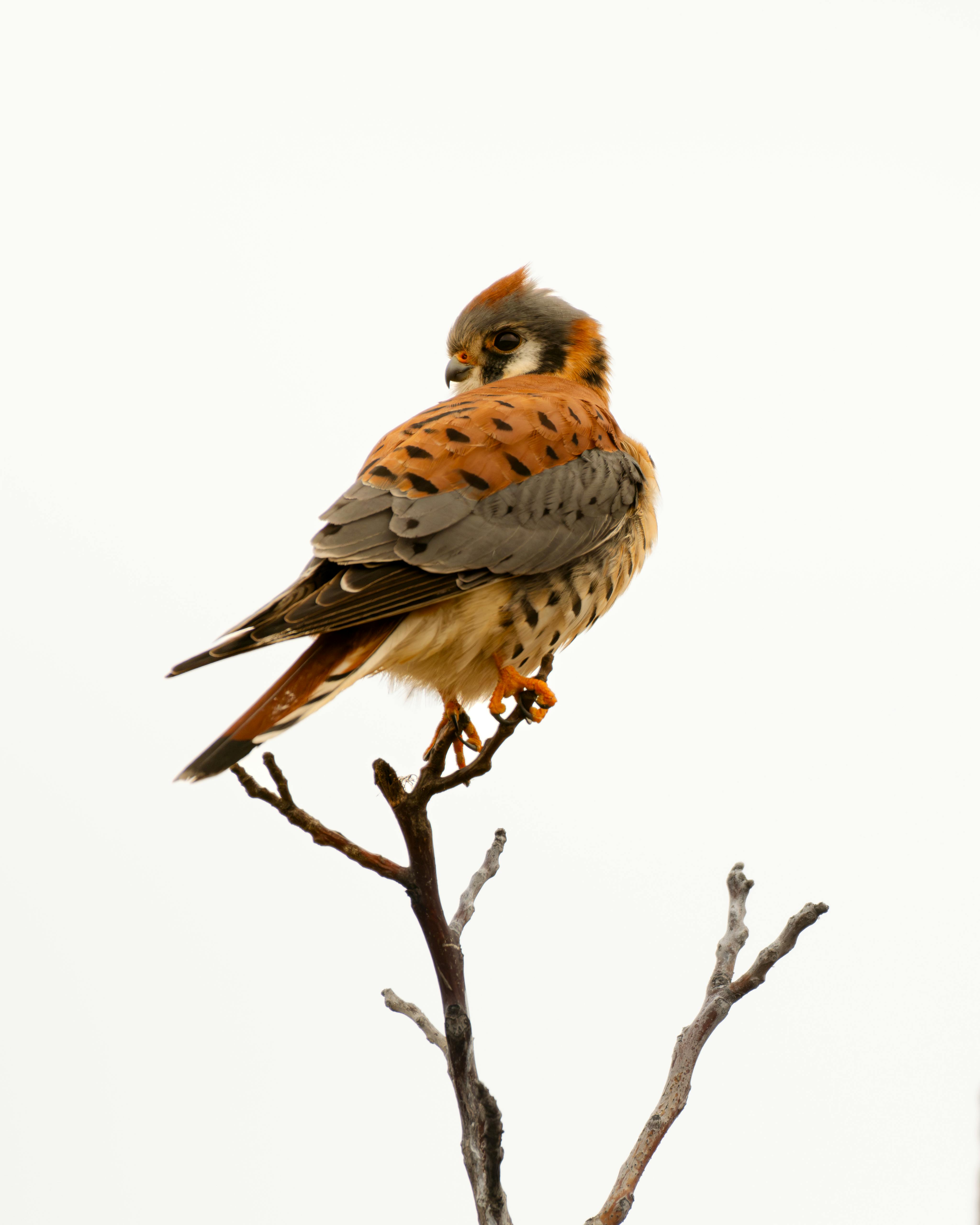
Frank Cone
The American Kestrel is the smallest falcon in North America, present in significant numbers throughout north, central, and South America, though their numbers are on the decline in the eastern United States. Any open or semi-open space with available perches is potential habitat for the American Kestrel, during winter, however, they may limit themselves to areas with appropriate nesting spaces. They nest in cavities of any kind, be it deadwood, rock, nest boxes, or buildings. The nestlings are ready to fly in about one month and then spend a few weeks learning to hunt with their parents before heading out on their own. On occasion, juvenile kestrels will fly and perch together and have been seen to temporarily form groups with other young kestrels. During the autumn and winter, the solitary Kestrels will spread out their territory if their food sources are limited, otherwise they will remain closer to each other. Their food sources are mostly small creatures: moths, crickets, grasshoppers, frogs, lizards, mice, and voles. Individual kestrels will often specialize in a particular type of prey to hunt. They will store food year round for times when a hunt is unsuccessful or food is scarce, returning within a few hours or days to eat. This helps to ensure that chicks survive when food is limited.
Kestrels often hunt from high perches, diving at speeds up to 60 mph, but can also be seen hovering in the air searching for prey, a technique called kiting or hanging. This is one of two birds on our list that is capable of hovering, the other is the Belted Kingfisher. Kestrels are known for their hovering and can be seen in fields on a windy day hovering by facing the wind by angling their wings upward and using controlled movements of their wings and tails to stay in place. Amazingly, on a calm day, they can hover by facing the slight wind, flapping furiously, and changing the angle of their wings on each downstroke to stay in place – this uses a great amount of energy and is used only for short amounts of time. The Kestrel will use a combination of gliding and hovering over a field when looking for food. This is a skill that the Kestrels learn, they are not born being able to hover, and they are clumsy when beginning to learn. The Kestrels’ vision is required for its survival in the wild. They are able to see within the ultraviolet light spectrum (UV). This helps them locate small rodents through their urine trails, which glow fluorescent yellow in UV, and helps them locate areas of high prey density. Their vision is also about 12 times sharper than ours. Put a piece of paper on a wall and back up until you can just make out the letters. Now measure that distance and mark out 11 more of those and see how much you can see of the letters. An American Kestrel could still read the letters!
BARRED OWL
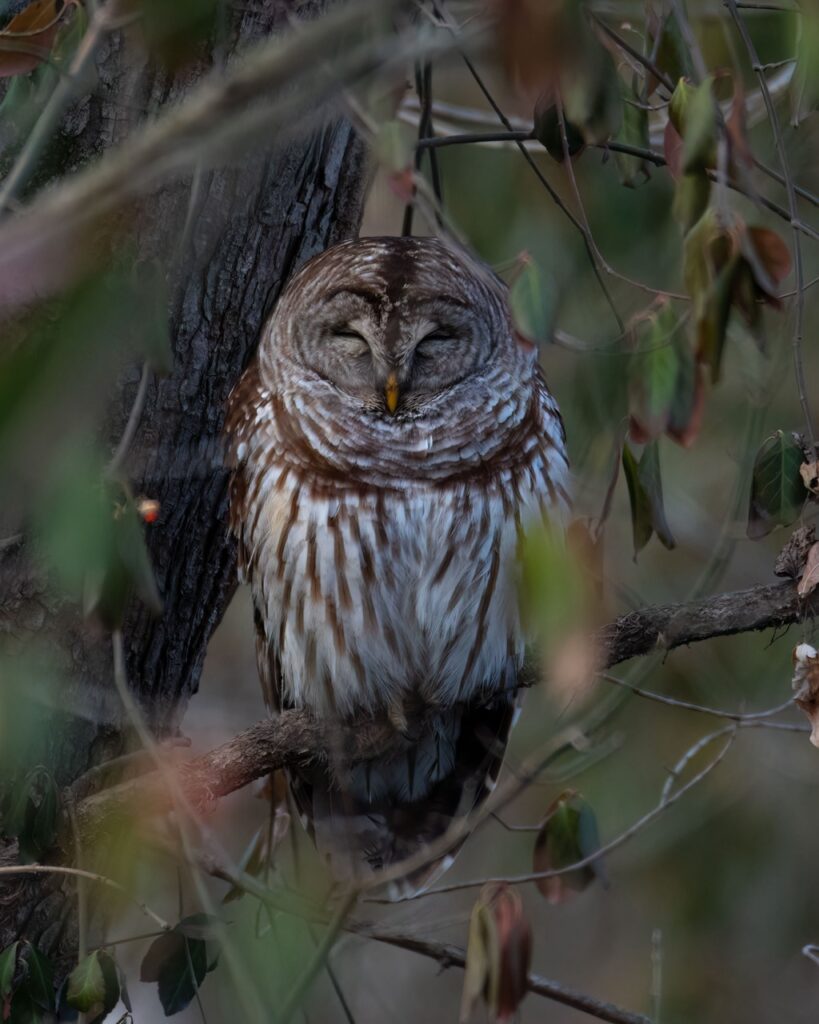
Eric Stuyck
The Barred Owl lives in forest, swamps, along river edges, and uplands throughout eastern North America and is usually a permanent resident, but there are a few northern populations who migrate if the weather gets too cold. Barred Owls nest between December and March and they scope out their nest site up to a year in advance. They build nests in cavities in deciduous trees, take over old nests made by crows and hawks, and use nest boxes when available. The nests are mostly left as they find them, but occasionally they decorate the nest with feathers, moss, or pine needles. After the young hatch, they will stay with their family members for up to 6 months. The juvenile owls climb trees by gripping the bark with their talons and beaks while flapping their wings and walking up the tree. They primarily eat small mammals, but will also eat insects, lizards, snakes, fish, and various other small creatures. They will wade out into the water to hunt crayfish and, if crayfish are a large part of their diet, the underneath of their wings can start to turn pink, much like flamingos with their shrimp diet. Barred Owls hunt almost entirely at night; it is a rarity to see them out and about during the day. Their eyes are large and can’t move in the sockets, but their necks have evolved to be incredibly flexible, allowing them to rotate their heads (and eyes) 135 degrees in either direction. Their eyes also have several adaptations to enable them to see in the dark, 100 times better than we can! Amazingly, they are able to independently contract the pupil of each eye, thereby controlling how much light gets into each eye, meaning that they can see perfectly in the day. Like other owls, special features of their feathers, comb-like serrations on the front and back of their wings, allow them to fly completely silently. They also have large wings compared to their bodies so they can fly very slowly – as slow as 2 mph – gliding silently with little flapping. They can live up to 27 years in the wild. Barred owls do not migrate much, if at all, over their lifetime; tracked barred owls were never found to move more than 6 miles from where they were first found.
AMERICAN CROW
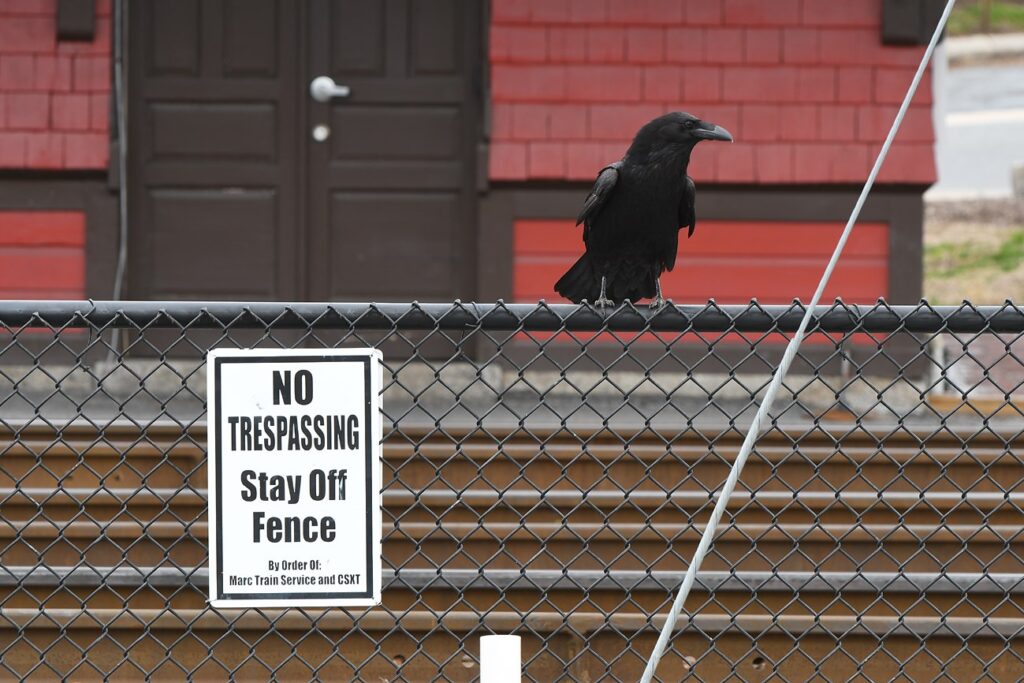
Eric Stuyck
The American crow is present all year in much of North America, only avoiding the arid deserts and the frozen tundra. They live up to 18 years old in the wild, and will form multigenerational families of up to 15 crows, with 1 to 5 generations. During the winter, it is common for them to gather together and form roosts, which can range from a few hundred to over a million birds. These roosting locations can be revisited by the same crows year after year, resulting in a permanent wintering crow population. They will eat pretty much anything that they can get their beaks on, and, thanks to their incredible intelligence, can access a wide variety of difficult food sources. They will use food to lure fish to make them easier to catch, they will work as a group to steal food from other animals, and, using their changing environment, they will drop hard nuts on the road, wait for cars to run over them, and then wait for the traffic light to turn red so they can safely pick up the feast. They are capable of creating and using simple and compound tools, such as shaping sticks to pry, push, or pull at things to access potential food, and using cups to carry water over a distance. Crows are able to solve multistep problems, learn, and pass on information. They also pass along “grudges” to friends and family. Crows who have never seen a “dangerous face” will learn from the other crows and harass and scream at the offender. This is a valuable ability teaching the community and future generations what things are dangerous. Crows also hold funerals and mourn for their dead. Funerals can be quiet or loud, attended by a single crow or a large group. They will even keep watch over the dead bird for days. Crows also love to play. I have seen crows in Brunswick spend hours, flying around a yard where a unique configuration of updrafts and downdrafts formed a ‘slide’ from the top of the house all the way across the yard. The crows took turns ‘sliding’ and laughing like a group of children. In spite of their capacity for joy, family structure, and amazing intelligence, people have hunted crows with a vengeance, shooting them and, in some cases, using dynamite to destroy entire roosts. In spite of their adaptability, they are still in danger. A native Hawaiian crow was declared extinct in the wild in 2002, but because there were some crows in captivity, scientists and the Hawaiian people have been working to bring them back through breeding programs and by removing the threats that brought the crow to extinction in 2002.
NORTHERN CARDINAL
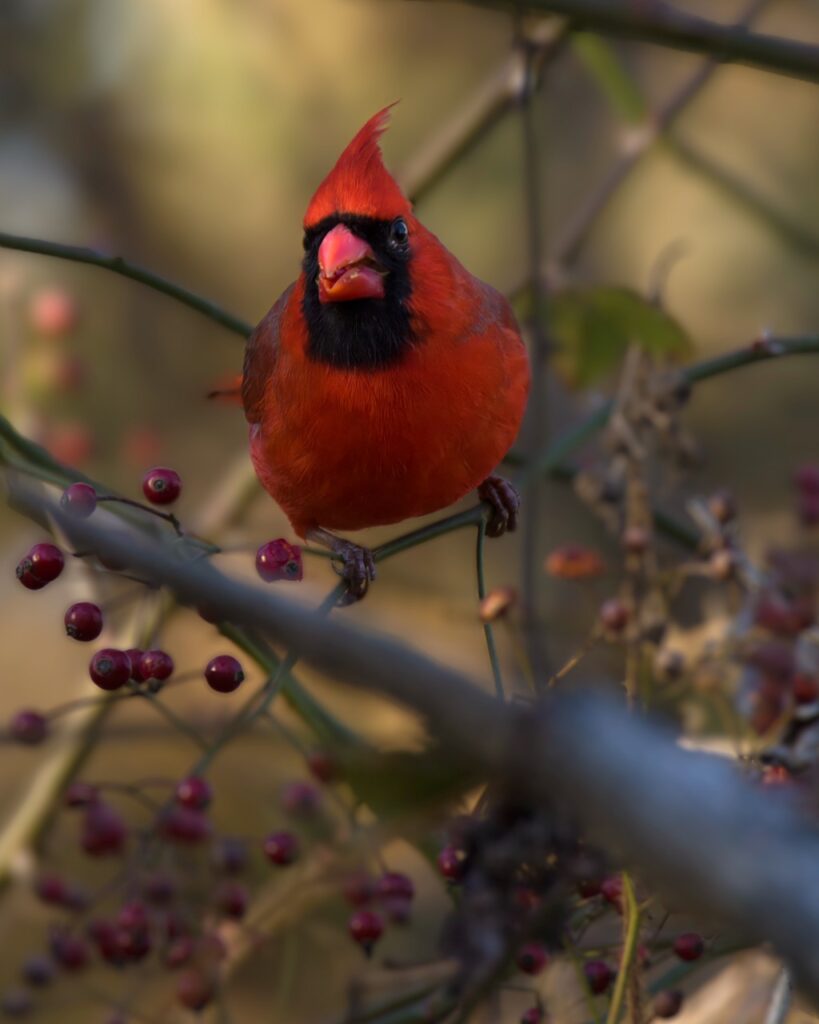
Eric Stuyck
The Northern Cardinal, known colloquially as ‘the Cardinal’ is a year-round native to eastern North America. It is a well-loved bird, perhaps because of its striking red color, its adorable red crest on its head, or the welcoming cheer-cheer-cheer call they make in early spring. It is the state bird of seven states, Illinois, Indiana, Kentucky, North Carolina, Ohio, Virginia, and West Virginia, which is more than any other bird. Male and female cardinals will pair together for the entire year, and will mark their territory by singing. They lay, on average, between 2–4 egg clutches per year, and can live up to 15 years old. Their primary food source is grain and seed, but they will also eat bugs, berries, fruit, and sap. The cardinals get their color from the berries and fruit such as mulberries and dogwood berries. The fruits contain carotenoids that create the red color. There is a rare genetic mutation that doesn’t allow the conversion of yellow pigment to red, so keep on the lookout and you could be one of the few to see a yellow northern cardinal. Cardinals are also one of the native birds that has been observed to eat the spotted lanternfly, a highly invasive bug that is projected to continue to grow in population and wreak havoc on crops and plants in Frederick county. Their eating of the invasive bug will be a welcome boon for the health of the various trees and shrubs in your backyard. The Cardinal is one of the few birds whose population has been increasing since the 1960’s, most likely due to global warming, increased edge habitat (places where two different plant communities meet), and the introduction of bird feeders during the winter.
TUFTED TITMOUSE
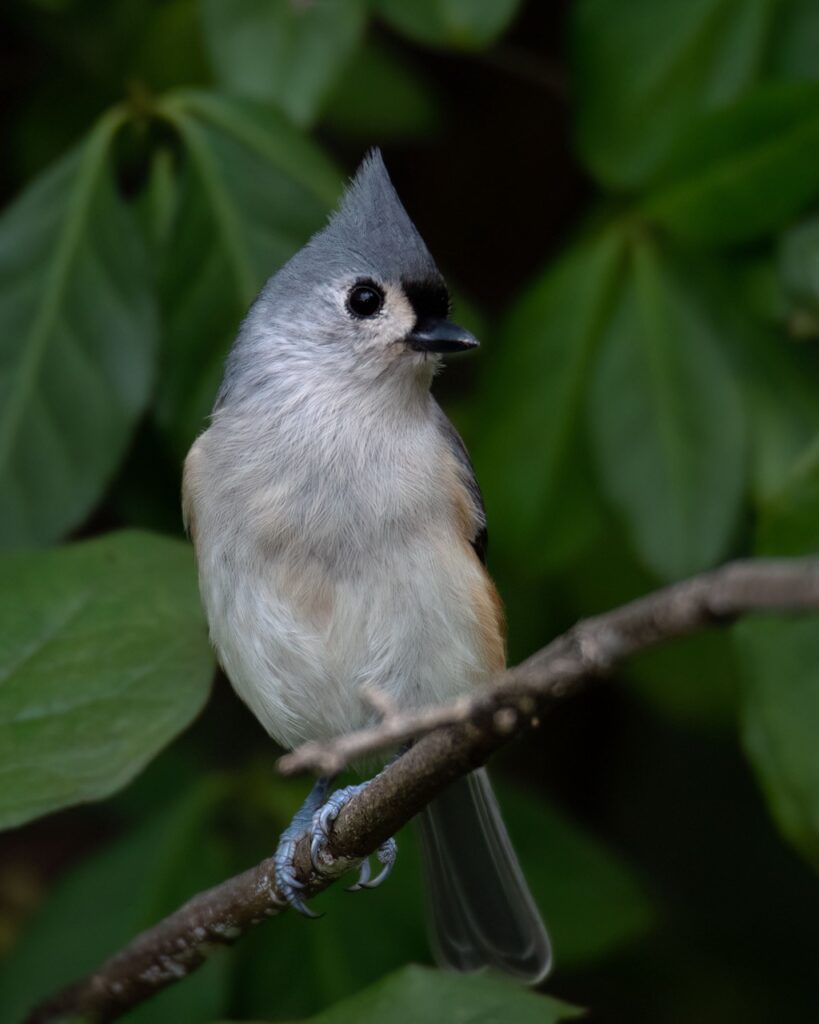
Eric Stuyck
The Tufted Titmouse is native to the eastern United States year round, and will choose to build their nests in pre-existing cavities, such as birdhouses, woodpecker holes, and standing deadwood. This little bird has several little characteristics that make it worthy of being a signature bird. The tufted titmouse is one of the birds who tucks away food for a rainy day. One seed at a time, they will hide the bounty of food from a bird feeder in locations within about 40 yards from the feeder. They also tend to shell the seeds before storing it away. So if you find a little store of seeds, you may have just come upon a Tufted Titmouse’s winter pantry. This little bird is also one of the few perching birds that is able to hold food in their feet. This highly vocal bird eats pretty much anything you can think that a songbird might eat—grains, seeds, berries, nuts, small fruits, caterpillars, bugs, and invertebrates such as slugs and snails. The parents lay one clutch of eggs each year, and cooperatively share in taking care of the eggs and hatchlings. The pair will often stay together in the years following, and can have children from previous years clutch of eggs stay with the parents and help raise their younger siblings, which increases the hatchling’s survival rate by as much as 20%. The Tufted Titmouse is also a master of deceit with its unique alarm call that sounds like the bird is moving off in the distance while it has actually not moved at all.
NORTHERN PARULA
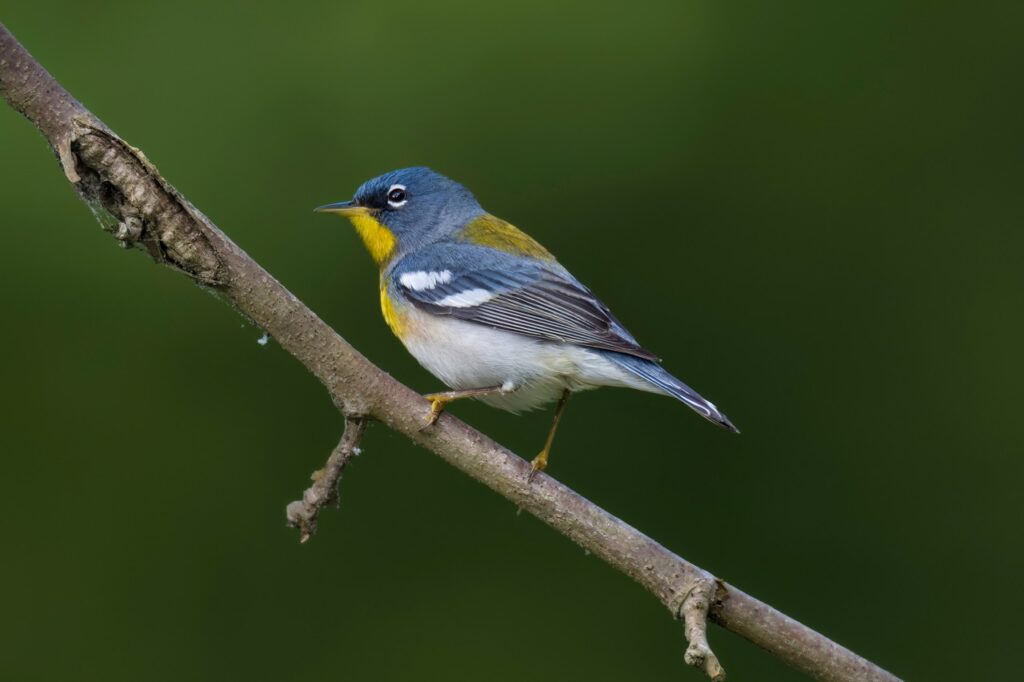
Eric Stuyck
The Northern Parula is a migratory bird that appears throughout the eastern United States over the course of late spring to early fall, their breeding season. During this season, they create pendulum nests, which are nests located within hanging vegetation, such as moss or twig clumps. These nests are created by burrowing into the vegetation and making a small space that will be filled with nesting material such as leaves, hair, and pine needles. They prefer to nest near water sources and within bottomland forest, which is forest that is located in submerged or often submerged wetlands. The presence of this species during the summer is a good indicator for a healthy riverside forest, as environmental disruption will cause their preferred habitat to disappear from the area, as has happened throughout much of the Midwest. The northern Parula can often be found foraging for insects and other bugs in high to middle tree canopy levels or at the end of branches. Their favorites are caterpillars, but they will eat moths, beetles, ants, bees, wasps, flies, and spiders.
CEDAR WAXWING
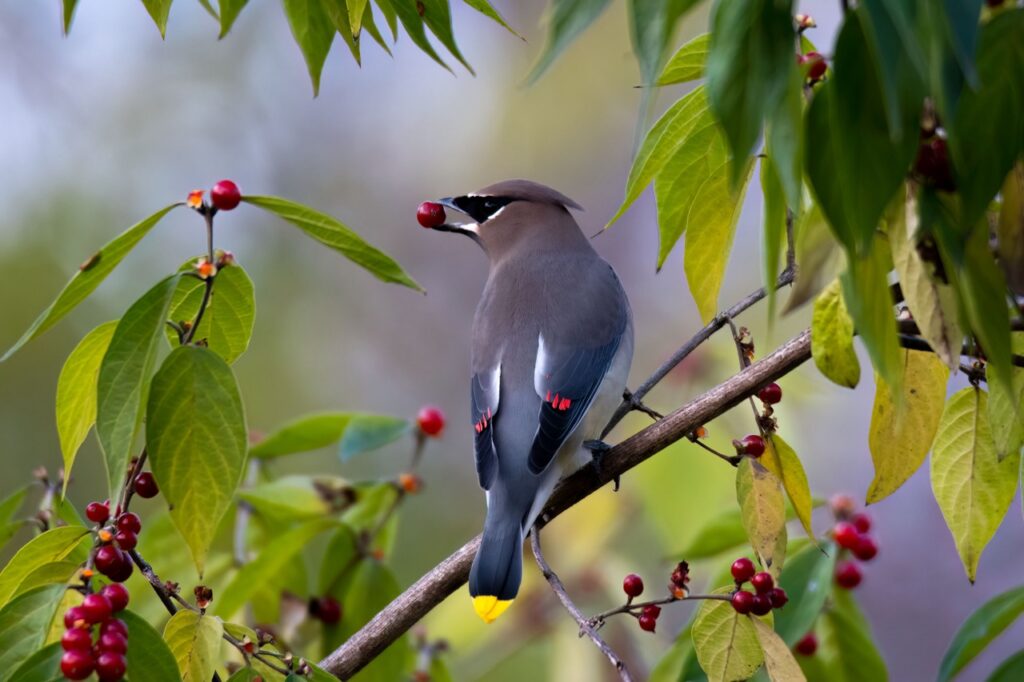
Eric Stuyck
Cedar Waxwings are a migratory bird that is present in the region year-round. They can be found in open woodlands and fruiting trees, as their diet consists primarily of berries such as serviceberry, winterberry, juniper, and dogwood berries which they swallow whole. They also eat insects, mostly during the breeding season, often snatching them from above the water with their quick speed. Their breeding season is delayed until later in the summer when there is a plethora of insects and ripe berries. They will have one or two broods depending on the fruit availability. During winter they will inhabit any wooded or semi-open space where berries are abundant. Waxwings are non-territorial and rather social, gathering in large mixed species flocks during non-breeding seasons. During the breeding season, they build their nests in close proximity to one another. They work as a group to find berries and will take turns sharing fruit from a bush. If a clump of berries are bunched up so much that only a single bird can access them, waxwings will often line up on the branch and pass the berries down the line from beak to beak so that every bird gets the chance to eat. During courtship, the male and female cedar waxwings will often sit together and pass small objects, such as a flower petal or an insect, to each other and rub beaks.
PROTHONOTARY WARBLER
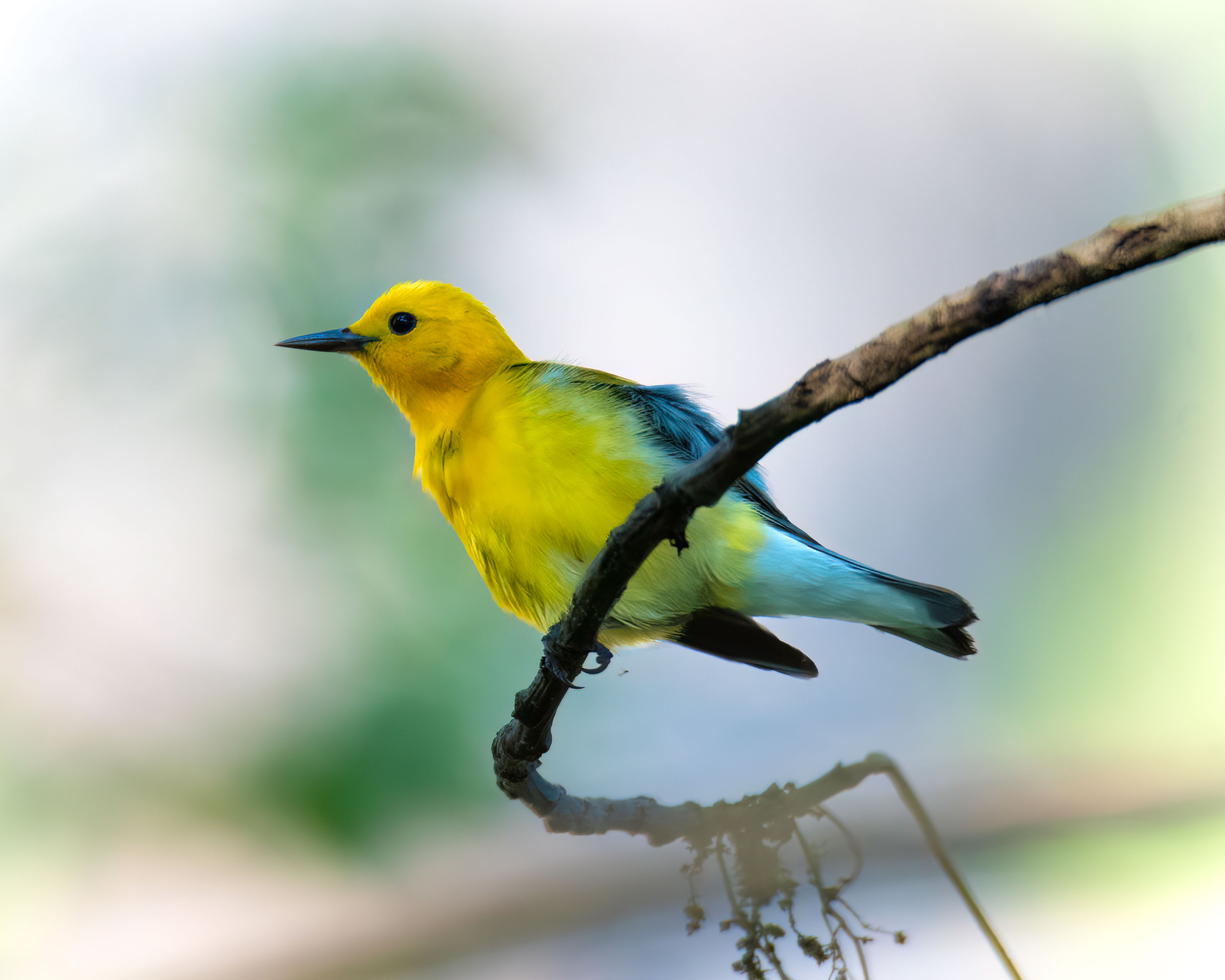
Eric Stuyck
The Prothonotary Warbler is a migratory bird who travels south as far as northern South America and as far north as southern New York. They can be spotted in the area during the summer breeding season, nesting near any water – swampy forest, lakes, streams, or the shores of slow moving or still bodies of water. During the winter, they nest in mangroves which are being destroyed during construction of developments, highways, and agriculture. This along with the destruction of forests in the United States has led to the decline in the population. Their nests are often parasitized by Brown-headed Cowbirds if the opening to the cavity is large enough and the warblers will abandon the nest once the cowbird egg is introduced. They tend to nest in cavities, such as nestboxes, woodpecker holes, and hollow stumps, but will also nest in human-made nest boxes with small openings. During the breeding season, the male chooses several nesting cavities and lines the nests in moss. The female chooses a mate based on the number and quality of nests. Prothonotary Warblers are territorial during the breeding season and will chase after an intruder with a snapping beak. During the winter, they will live peacefully together. They will spar in the air, locking beaks and feet and falling to the ground. They feed on insects such as flies, beetles, insect larvae, caterpillars, spiders, and small invertebrates, such as snails and mollusks. They also eat fruit and seeds and use their bills to probe into old logs and branches to search for food. Its name, which is a bit of a mouthful, comes from a bright yellow hooded, old style of clothing worn by some court officials, known as prothonotaries.